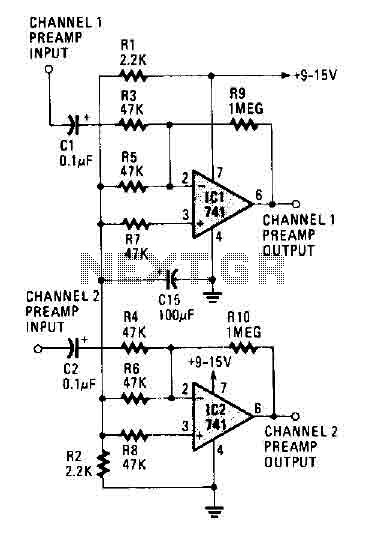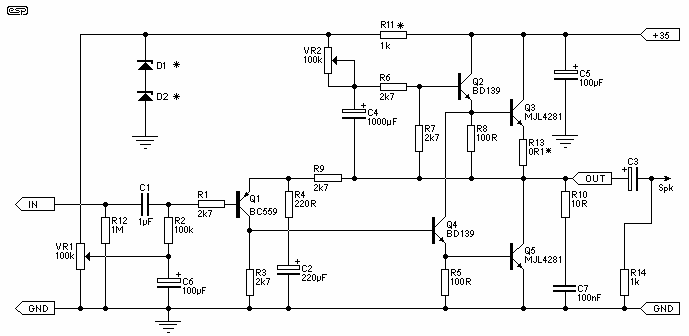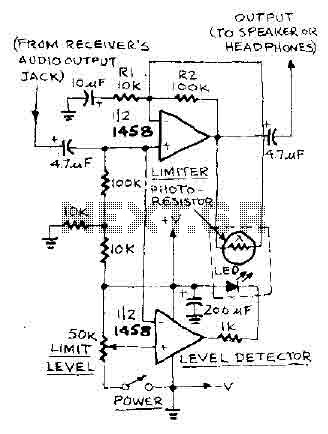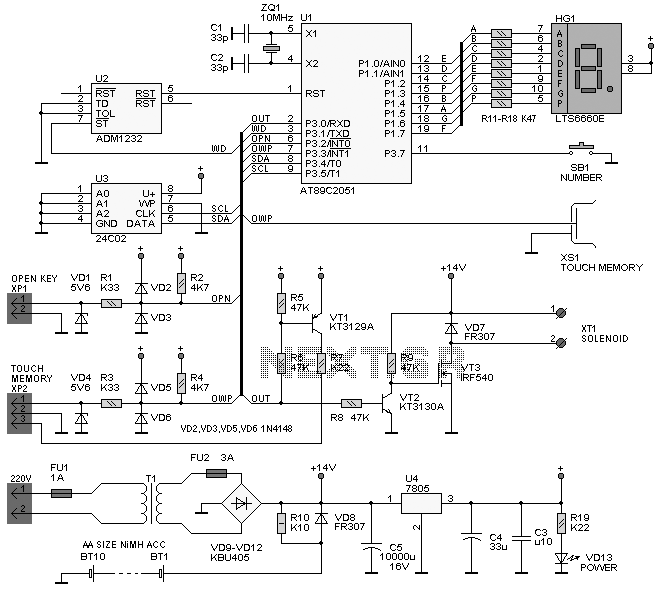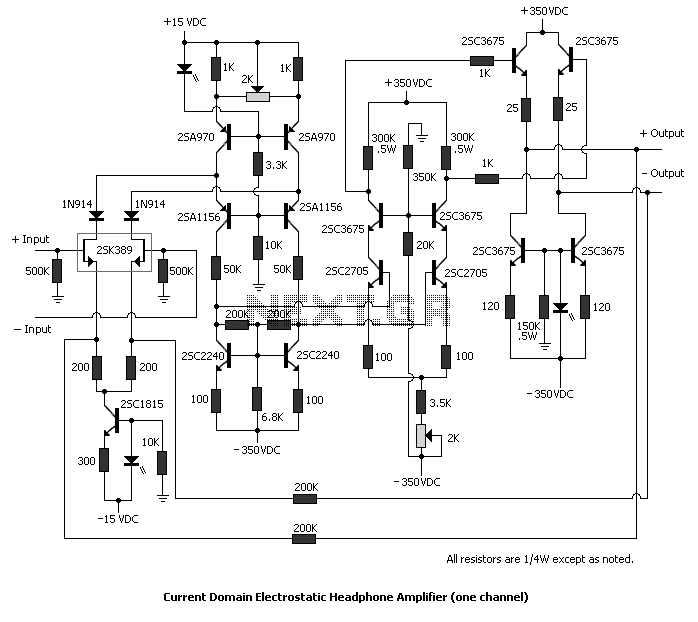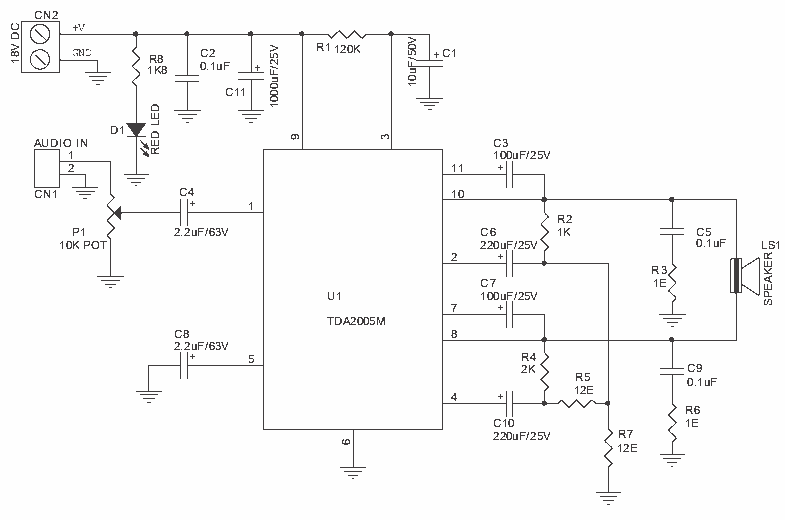
1w btl audio amplifier
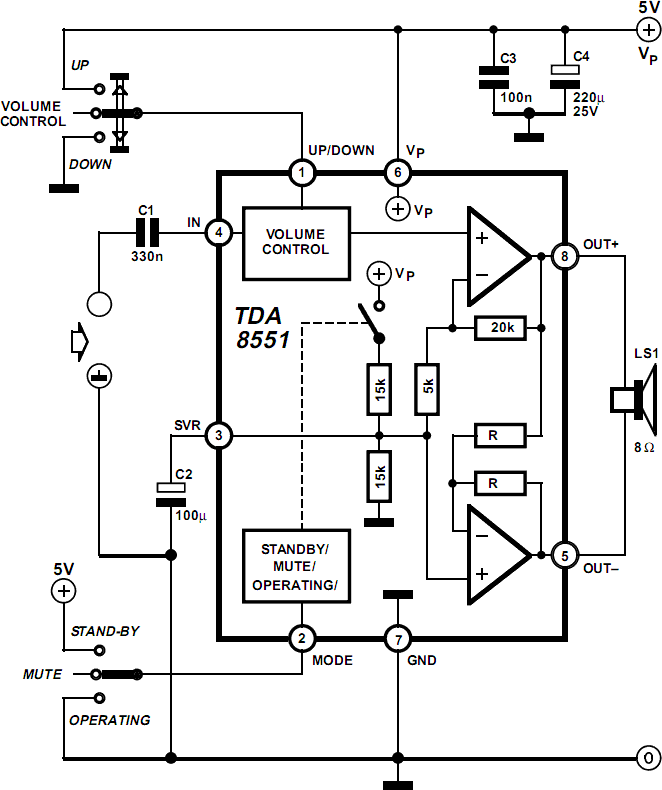
The TDA8581(T) from Philips Semiconductors is a 1-watt Bridge Tied Load (BTL) audio power amplifier that can deliver 1 watt of output power into an 8-ohm load at a total harmonic distortion (THD) of 10% while using a 5V power supply. The schematic provided combines the functional diagram of the TDA8551 with its typical application circuit. The amplifier's gain can be adjusted via a digital volume control input, with a maximum gain of 20 dB at the highest volume setting. The device can be switched between three modes using the MODE pin: standby (MODE level between Vp and Vp - 0.5 V), muted (MODE level between 1 V and Vp - 1.4 V), or normal (MODE level less than 0.5 V). The TDA8551 includes an internal thermal shutdown protection mechanism. The total voltage drop across both MOS transistors in the complementary output stage is less than 1 V. With a 5V supply and an 8-ohm loudspeaker, it can deliver an output power of 1 watt. The volume control features an attenuation range of 0 dB to 80 dB in 64 steps, controlled by the 3-state level at the UP/DOWN pin: floating (volume unchanged), negative pulses (decrease volume), and positive pulses (increase volume). Each pulse at the UP/DOWN pin results in a gain change of approximately 1.25 dB (80/64). Upon initial power connection, the attenuator is set to 40 dB (low volume), giving the amplifier a gain of 20 dB. To achieve listening volume, several positive pulses must be applied to the UP/DOWN pin. The THD is presented as a function of output power. The maximum quiescent current consumption of the amplifier is specified at 10 mA, plus the current resulting from the output offset voltage divided by the load impedance.
The TDA8581(T) operates effectively as a compact audio power amplifier suitable for various applications requiring efficient sound amplification. Its design allows for integration into consumer electronics, such as portable speakers and compact audio systems, where space and power efficiency are critical. The use of a BTL configuration enhances the output power capability while minimizing the need for additional components, reducing the overall footprint of the device.
The digital volume control feature provides a user-friendly interface for adjusting sound levels, enhancing the usability of the amplifier in applications where precise volume control is desired. The 64-step attenuation allows for fine-tuning of audio output, accommodating different listening environments and user preferences. The ability to switch between operational modes ensures flexibility in usage scenarios, allowing the amplifier to enter a low-power standby state when not in use, thereby conserving energy.
Thermal protection is a vital feature of the TDA8551, safeguarding the amplifier from potential damage due to overheating, which can occur during prolonged use or under high load conditions. The low voltage drop across the output stage contributes to the overall efficiency of the amplifier, allowing it to operate effectively within the constraints of a 5V power supply.
In summary, the TDA8581(T) is a versatile audio amplifier that combines efficiency, flexibility, and user control, making it an ideal choice for modern audio applications. Its design considerations, including thermal protection and digital volume control, contribute to reliable performance and enhanced user experience in audio amplification tasks.The TDA8581(T) from Philips Semiconductors is a 1-watt Bridge Tied Load (BTL) audio power amplifier capable of delivering 1 watt output power into an 8-Wload at THD (total harmonic distortion) of 10% and using a 5V power supply. The schematic shown here combines the functional diagram of the TDA8551 with its typical application circuit.
The gain o f the amplifier can be set by the digital volume control input. At the highest volume setting, the gain is 20 dB. Using the MODE pin the device can be switched to one of three modes: standby (MODE level between Vp and Vp 0. 5 V), muted (MODE level between 1 V and Vp 1. 4 V) or normal (MODE level less than 0. 5 V). The TDA8551 is protected by an internal thermal shutdown protection mechanism. The total voltage loss for both MOS transistors in the complementary output stage is less than 1 V. Using a 5-V supply and an 8-W loudspeaker, an output power of 1 watt can be delivered. The volume control has an attenuation range of between 0 dB and 80 dB in 64 steps set by the 3-state level at the UP/DOWN pin: floating: volume remains unchanged; negative pulses: decrease volume; positive pulses: increase volume Each pulse at he Up/DOWN pin causes a change in gain of 80/64 = 1.
25 dB (typical value). When the supply voltage is first connected, the attenuator is set to 40 dB (low volume), so the gain of the total amplifier is then 20 dB. Some positive pulses have to be applied to the UP/DOWN pin to achieve listening volume. The graph shows the THD as a function of output power. The maximum quiescent current consumption of the amplifier is specified at 10mA, to which should be added the current resulting from the output offset voltage divided by the load impedance.
🔗 External reference
The TDA8581(T) operates effectively as a compact audio power amplifier suitable for various applications requiring efficient sound amplification. Its design allows for integration into consumer electronics, such as portable speakers and compact audio systems, where space and power efficiency are critical. The use of a BTL configuration enhances the output power capability while minimizing the need for additional components, reducing the overall footprint of the device.
The digital volume control feature provides a user-friendly interface for adjusting sound levels, enhancing the usability of the amplifier in applications where precise volume control is desired. The 64-step attenuation allows for fine-tuning of audio output, accommodating different listening environments and user preferences. The ability to switch between operational modes ensures flexibility in usage scenarios, allowing the amplifier to enter a low-power standby state when not in use, thereby conserving energy.
Thermal protection is a vital feature of the TDA8551, safeguarding the amplifier from potential damage due to overheating, which can occur during prolonged use or under high load conditions. The low voltage drop across the output stage contributes to the overall efficiency of the amplifier, allowing it to operate effectively within the constraints of a 5V power supply.
In summary, the TDA8581(T) is a versatile audio amplifier that combines efficiency, flexibility, and user control, making it an ideal choice for modern audio applications. Its design considerations, including thermal protection and digital volume control, contribute to reliable performance and enhanced user experience in audio amplification tasks.The TDA8581(T) from Philips Semiconductors is a 1-watt Bridge Tied Load (BTL) audio power amplifier capable of delivering 1 watt output power into an 8-Wload at THD (total harmonic distortion) of 10% and using a 5V power supply. The schematic shown here combines the functional diagram of the TDA8551 with its typical application circuit.
The gain o f the amplifier can be set by the digital volume control input. At the highest volume setting, the gain is 20 dB. Using the MODE pin the device can be switched to one of three modes: standby (MODE level between Vp and Vp 0. 5 V), muted (MODE level between 1 V and Vp 1. 4 V) or normal (MODE level less than 0. 5 V). The TDA8551 is protected by an internal thermal shutdown protection mechanism. The total voltage loss for both MOS transistors in the complementary output stage is less than 1 V. Using a 5-V supply and an 8-W loudspeaker, an output power of 1 watt can be delivered. The volume control has an attenuation range of between 0 dB and 80 dB in 64 steps set by the 3-state level at the UP/DOWN pin: floating: volume remains unchanged; negative pulses: decrease volume; positive pulses: increase volume Each pulse at he Up/DOWN pin causes a change in gain of 80/64 = 1.
25 dB (typical value). When the supply voltage is first connected, the attenuator is set to 40 dB (low volume), so the gain of the total amplifier is then 20 dB. Some positive pulses have to be applied to the UP/DOWN pin to achieve listening volume. The graph shows the THD as a function of output power. The maximum quiescent current consumption of the amplifier is specified at 10mA, to which should be added the current resulting from the output offset voltage divided by the load impedance.
🔗 External reference
